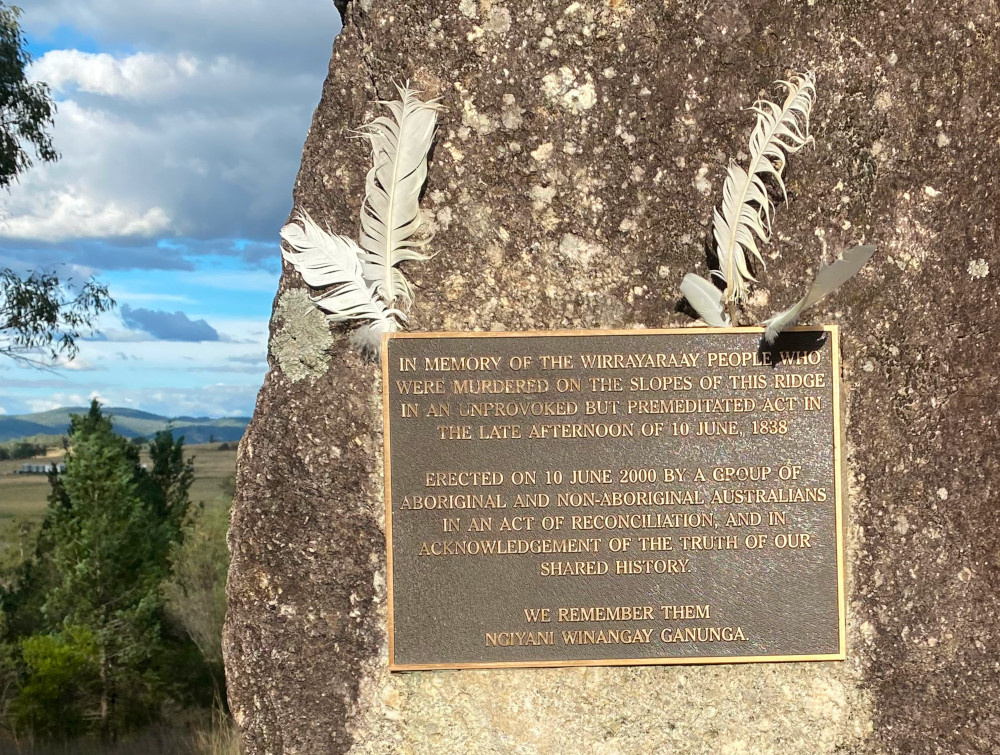Two similar sayings tie together two days to remember mass death. “Ngiyana winangay ganunga: We remember them” is the motto inscribed at the Myall Creek massacre site; “let we forget” binds our remembrances on ANZAC Day.
Grey nomadic travelling brought me to Myall Creek on Anzac Eve. As we left the town of Bingara, home to a wonderfully preserved Greek cafe, the countryside, which had seemed rhapsodic, turned sombre. The hills turned to a sad grey. And the massacre site, a lonely hillside away from the town, was wrapped in silence.
We had come to Gomeroi land. A place where both their dispossession and the benefits I, as a non-indigenous person living in Australia, benefit from spoke in the silence.
Silence because on the late afternoon of 10 June 1838, a posse of ten stockmen led by a squatter headed down the slope to Myall Creek, slaughtering about 28 aboriginal people, mostly older men, women and children.
It was one of many massacres in the district that killed hundreds, one of many massacres across the lands that became Australia. But it was an unusual massacre in that it incurred a follow-up with seven hangings.
But on this day, the silence spoke not of justice but of absence.
As I walked the serpentine path that leads down the slope, the stillness was broken only by magpies cawing in the distance and my awareness that this was a valley of death. The names of those who died are not recorded, and down along the path, those who brought most of those perpetrators, but not the ringleader, to justice are not named. In this valley of the un-named, there is an equality, respected each June when the descendants of those who died, those who instigated the massacre and those who brought some justice meet.
The path snakes down the slope, with memorials to each stage of the massacre – the general campaign of slaughter, an invitation to Myall Creek as a place of safety, the absence of the young men on an expedition to strip bark, a day of horror and the slaughter on the slope.
As I climbed back up the serpentine path, the local birds burst into song.
On this trip, Anzac remembrance was strong, with war memorials in towns across the Tablelands and northern plains. Scores of names are etched into marble. Tragically, surnames match on the lists of the fallen brothers who lie in Flanders fields and beyond. The war against the Aboriginal peoples has not made it onto the war memorials yet.
The Anzac tale was retold at the memorial service at Tingha, a small town not far from Myall Creek outside Inverell. The town gathered at the war memorial with Tingha’s long lists of names and a digger cast in bronze. “The Anzacs landed April 25, 1915, and 2,000 Australians died that day,” we were told. “It was a day of confusion and fear. One soldier called it ‘a day of sorrow.'” In paying tribute to the fallen, Tingha did not glorify war.
Under a sunny sky (the gloom of the previous day had lifted,) the crowd mostly wore uniforms – the catafalque party from the Airforce, a trooper mounted on a horse in Army Uniform, the Firies and the local Tingha Tigers Rugby League team, and in maroon, the visiting Inverell Hawks from the big smoke.
This day, too, had its silences – deliberate and moving silences. There was a long silence after the last post, the longer silence as the small town, from the children wearing the blue jerseys of the local school to the medalled vets, Catholics and “the Church of England,” the SES and the Aboriginal Health Service (in Tigers colours), laid wreaths. We prayed to Almighty God and finished with “Abide With Me.”
After we were dismissed, we were invited to inspect the Steyr machine guns held by the catafalque party by the MC who recalled his SLR, and the townsfolk adjourned to lunch in the sports and rec club.
Image: Myall Creek massacre memorial


Thank you John.